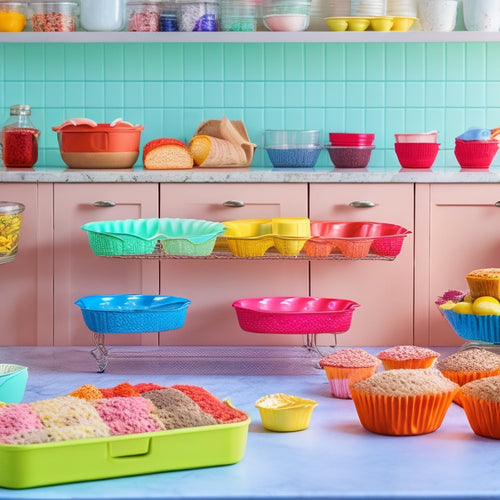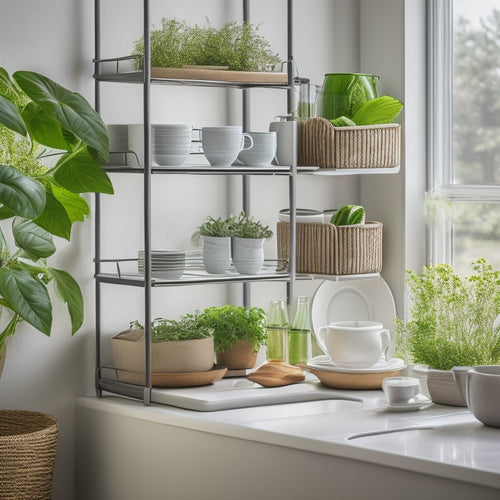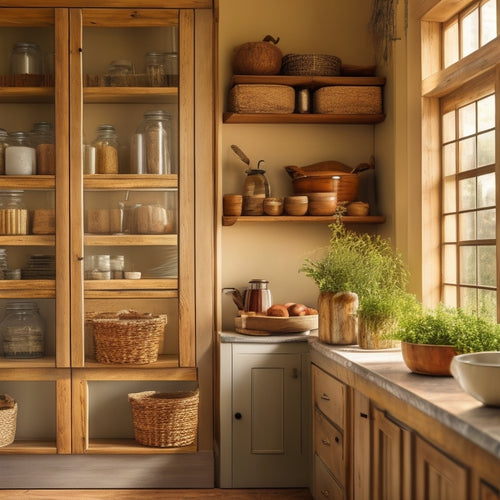
Why Kitchen Utensil Organization Eludes Wheelchair Users
Share
You face a unique set of challenges in the kitchen, where traditional utensil storage solutions often overlook your needs as a wheelchair user, forcing you to navigate a maze of inaccessible shelves, countertops, and cabinets. Customized shelving and hidden compartments can help, but you need more. Limited counter space and hard-to-reach utensils only add to the frustration. Rotating racks, hanging baskets, and adaptive utensil holders can provide some relief. But to achieve true independence in meal prep, you need a wheelchair-friendly utensil layout that prioritizes accessibility and ergonomic design. Now, discover how to create a kitchen that works with you, not against you.
Key Takeaways
• Wheelchair users face challenges in kitchen utensil storage due to inaccessible high shelves, deep cabinets, and countertops.
• Limited counter space necessitates creative storage solutions like hanging racks, magnetic strips, and under-cabinet hooks.
• Hard-to-reach utensils can be accessed using adjustable utensil holders, pull-down shelves, and slide-out drawers.
• Adaptive utensil holders with non-slip bases and wall-mounted designs can increase independence in meal preparation.
• Inaccessible kitchen utensil organization systems can lead to frustration, reduced independence, and a lack of confidence in meal preparation.
Kitchen Utensil Storage Challenges
You may face unique kitchen utensil storage challenges as a wheelchair user, particularly when it comes to accessing high shelves, deep cabinets, or countertops that are too high to reach comfortably. This can be frustrating, especially when you need to cook or prepare meals independently.
To overcome these challenges, consider customized shelving that brings frequently used items within your reach. Install hidden compartments or pull-out drawers that allow you to store items like pots, pans, and utensils at a comfortable height.
Rotating racks and hanging baskets can also be game-changers. They enable you to maximize vertical storage space while keeping items easily accessible. For instance, you can store spices, oils, or condiments on a rotating rack near your cooking station, or hang baskets to store snacks, fruits, or kitchen linens.
Limited Counter Space Solutions
A cluttered countertop can be a major obstacle in your kitchen, especially when limited mobility makes it difficult to navigate around crowded spaces. As a wheelchair user, you need a clear path to access essential utensils and cookware.
One effective solution is to utilize vertical space by installing hanging utensil racks or wall-mounted utensil holders. These allow you to store frequently used items, keeping them within easy reach while freeing up counter space.
Another option is to take advantage of the magnetic properties of utensil strips, which can be attached to the side of a cabinet or fridge, providing a convenient spot to store metal utensils.
Additionally, consider using under-cabinet hooks to hang items like oven mitts, aprons, or even a dish towel, keeping them organized and out of the way.
Hard to Reach Utensils
Reaching for utensils stored in high cabinets or on back shelves can be a daily struggle, requiring awkward stretching or relying on assistance. You're not alone in this frustration.
As a wheelchair user, finding solutions that provide easy access to your kitchen essentials is crucial. One approach is to explore utensil height adjustments. This might involve installing pull-down shelves or adjustable cabinet organizers that bring utensils within your comfortable reach. You can also repurpose lower cabinets or shelves to store frequently used items, reducing the need to stretch or strain.
Another option is to explore convenient access solutions, such as slide-out utensil drawers or turntables that bring items to you. These innovative designs can be installed in existing cabinets or incorporated into your kitchen layout during a renovation.
Adaptive Utensil Holder Options
Turn to adaptive utensil holders that cater specifically to your needs, offering customized support and stability for your kitchen tools. These innovative storage solutions are designed to make cooking more accessible and enjoyable for wheelchair users.
With customizable utensil holders, you can tailor the layout to fit your unique requirements, ensuring that your most frequently used utensils are within easy reach.
Look for adaptive utensil racks that provide space-saving options, such as wall-mounted or countertop designs that maximize vertical storage. This will help keep your kitchen countertops clear and clutter-free, making it easier to navigate your workspace.
Some adaptive utensil holders also feature adjustable compartments, allowing you to accommodate utensils of various sizes and shapes.
When selecting an adaptive utensil holder, consider the materials and construction. Durable, easy-to-clean materials like stainless steel or silicone are ideal for withstanding heavy use. Additionally, look for holders with non-slip bases or suction cups to prevent them from shifting or toppling over.
Wheelchair Friendly Utensil Layout
You'll want to position your utensils in a way that creates a workflow that's intuitive and efficient, with the most frequently used items at your fingertips, and less common ones stored out of the way but still accessible. This means considering the 'golden zone' around your wheelchair, where you can easily reach without straining or leaning.
Install ergonomic utensil holders at comfortable heights to reduce fatigue and promote independence. Adjustable kitchen layouts can also be tailored to your needs, ensuring that countertops and storage are within easy reach.
When designing your wheelchair-friendly utensil layout, prioritize utensil accessibility solutions. Store heavy or bulky items in wheelchair accessible storage, such as lower cabinets or drawers with easy-glide mechanisms. Labeling storage containers can help you quickly identify what's inside, saving time and energy.
Corner Space Maximization Ideas
By thoughtfully utilizing the often-wasted corner spaces in your kitchen, you can create a more efficient and organized cooking environment that works with your wheelchair accessibility needs. Corner areas can be particularly challenging for wheelchair users, but with some clever solutions, you can turn these spaces into valuable storage areas.
Consider installing innovative shelving that's specifically designed for corner spaces. These shelves can be adjusted to fit your wheelchair's height, allowing you to easily access items without straining or struggling.
You can also use creative wall mounts to hang utensils, pots, and pans, keeping them within easy reach. This won't only free up counter space but also reduce clutter.
To maximize corner space, think vertically. Install shelves or a pegboard on the wall, and use hooks or bins to store items like spices, oils, or cooking utensils. By doing so, you'll create a functional and accessible cooking area that caters to your needs.
With a little creativity, you can turn those once-wasted corner spaces into a valuable asset in your kitchen.
Utensil Organization for One-Handed
As a wheelchair user who often cooks with one hand, you're likely familiar with the frustration of juggling utensils while trying to prepare a meal, and that's why arranging your utensils in a way that accommodates your needs is essential.
Here are some one-handed utensil solutions to explore:
| Utensil Type | Adaptive Solution | Benefits |
| Spatula | Adaptive utensil grip with contoured handle | Reduces strain on wrist and hand |
| Whisk | Creative utensil holder with suction cup base | Frees up hand for other tasks |
| Tongs | Ergonomic utensil tool with angled grip | Allows for easier grasping and control |
| Measuring Cups | One-handed measuring cup with ergonomic handle | Simplifies measurement process |
These adaptive utensil solutions can greatly enhance your cooking experience. By incorporating creative utensil holders and ergonomic utensil tools into your kitchen, you'll be able to cook with greater ease and independence. Remember, it's all about finding the right tools to fit your needs, and with a little creativity, you can cook up a storm!
Adjustable Utensil Storage Systems
Your kitchen utensil storage system should adapt to your changing needs, which is why adjustable storage solutions are a game-changer for wheelchair users who require flexible accessibility.
As you navigate your kitchen, you need a system that can accommodate your unique requirements, whether that means adjusting shelf heights or rearranging hooks to suit your reach.
Adjustable utensil storage systems offer a range of benefits, including:
-
Customizable shelving: shelves that can be easily moved up or down to accommodate your changing needs
-
Multi-functional hooks: hooks that can be adjusted to hold utensils of varying sizes and shapes
-
Easy reconfiguration: storage systems that can be easily rearranged as your needs change
- Increased independence: adjustable storage solutions that empower you to cook and prepare meals with confidence
Accessible Utensil Drawer Organizers
Arrange your utensil drawer to maximize accessibility with organizers specifically designed for wheelchair users, providing a seamless cooking experience.
You'll appreciate the customized dividers that separate utensils, making it easy to find what you need without having to dig through a cluttered drawer. These dividers are often made of durable materials that can withstand frequent use.
Look for organizers with a compact design that fit snugly in your utensil drawer, allowing for easy access to your cooking essentials. This is especially important for wheelchair users who may have limited reach or mobility.
With an accessible utensil drawer organizer, you can cook with confidence, knowing that your tools are within reach.
When selecting an organizer, prioritize easy access and durability. Consider an organizer with adjustable compartments to accommodate utensils of various sizes.
By investing in an accessible utensil drawer organizer, you'll be able to cook with independence and freedom, without the frustration of a cluttered or inaccessible drawer.
With the right organizer, you'll be whipping up meals in no time, without having to worry about the logistics of utensil storage.
Frequently Asked Questions
Can I Customize Utensil Organizers to Fit My Specific Wheelchair Needs?
Did you know that 1 in 5 people with disabilities face daily kitchen challenges? You can definitely customize utensil organizers to fit your specific wheelchair needs, offering adaptable, accessible, and personalized solutions that cater to your unique requirements.
How Do I Clean Utensil Organizers With Limited Dexterity or Strength?
You'll find cleaning utensil organizers with limited dexterity or strength manageable by using long-handled cleaning tools, soft brushes, and gentle cleaning products, making accessibility solutions a priority for easy maintenance.
Are There Any Utensil Organizers With Built-In Utensil Identifiers for Visually Impaired Users?
You're about to uncover a game-changer! Yes, there are utensil organizers with built-in identifiers for visually impaired users. Look for ones with Braille labels or color coding to help you easily distinguish between utensils, making cooking a breeze.
Can I Use Wall-Mounted Utensil Organizers if I Have a Drop Ceiling?
You can still optimize your kitchen space with wall-mounted utensil organizers despite having a drop ceiling. Consider alternative storage solutions that prioritize accessibility, like adjustable shelves or hooks that accommodate your needs.
Are There Any Smart Utensil Organizers That Can Track Utensil Usage and Suggest Organization Improvements?
You'll love smart utensil organizers that track usage and offer organization suggestions! Some models use sensors, while others rely on manual input. Look for ones with accessible interfaces, like voice control or large buttons, to make utensil tracking and optimization a breeze.
Related Posts
-

Roll-Out Trays for Organizing Baking Supplies
Roll-out trays are perfect for organizing your baking supplies, making your kitchen more efficient. They maximize spa...
-

Tiered Dish Rack Organizers for Compact Spaces
Tiered dish rack organizers are perfect for compact spaces, maximizing vertical storage while saving precious counter...
-

Freestanding Pantry Units for Farmhouse Kitchen Style
Freestanding pantry units perfectly blend beauty and function in your farmhouse kitchen. They maximize storage while ...


